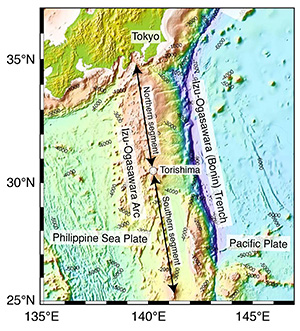Press Releases
September 27, 2016
JAMSTEC
New Hypothesis of Birth of Continents
- Nishinoshima may be recreating the continental crust formation from a waterworld in the early Earth -
Overview
Dr. Yoshihiko Tamura, Research and Development Center for Ocean Drilling Science at the Japan Agency for Marine-Earth Science and Technology (JAMSTEC: Asahiko Taira, President) and his team presented the straightforward but unexpected relationship between crustal thickness and magma type in the Izu-Ogasawara (Bonin) and Aleutian oceanic arcs. Volcanoes along the southern segment of the Izu-Ogasawara arc and the western Aleutian arc (west of Adak) are underlain by thin crust (10-20 km). In contrast those along the northern segment of the Izu-Ogasawara arc and eastern Aleutian arc are underlain by crust ~35 km thick. Interestingly, andesite magmas dominate eruptive products from the former volcanoes and mostly basaltic lavas erupt from the latter.
According to the hypothesis presented here, rising mantle diapirs (source mantle of arc magmas) stall near the base of the oceanic crust at depths controlled by the thickness of the overlying crust. Where the crust is thin, melting occurs at relatively low pressures in the mantle wedge producing andesitic magmas. Where the crust is thick, melting pressures are higher and only basaltic magmas tend to be produced.
“How was the continents formed?” is one of major questions of Earth Sciences. Devoid of continents, Earth would have been a waterworld, which is enveloped by a monotonous crust of basalt and covered by ocean. The genesis of andesite in general is the key to understanding juvenile continental crust formation. This study shows that andesite is produced only when the crust is thin, thus only in oceanic arcs. If so, most andesite magmas erupted on continental crust could be recycled from primary andesite previously produced in oceanic arcs. It presents a new hypothesis that “continents are formed in ocean areas.” This finding is expected to make a significant contribution towards further elucidation of a mystery of the continental formation.
The above results were posted in the Scientific Reports on September 27, 2016 (JST).
- Title:
- Advent of Continents. A New Hypothesis
- Authors:
- Yoshihiko Tamura1, Takeshi Sato1, Toshiya Fujiwara1, Shuichi Kodaira1 & Alexander Nicolas1
- Affiliation:
- 1. JAMSTEC
- URL:
- http://www.nature.com/articles/srep33517


Figure 1. Crustal structures along the volcanic front of the Izu-Ogasawara arcs (Kodaira et al. 2007). The crust beneath the arc volcanoes in the northern segment of the Izu-Ogasawara arcs is 32 - 35 km thick, while that in the southern segment including Nishinoshima is 16 - 21 km, being remarkably thinner.

Figure 2. Water depth and crustal thickness along the seismic profile (figure 1).
It shows that crust is thick in areas where the water depth is shallow. A clear relationship between water depth and crustal thickness is observed between volcanoes.

Figure 3. Depth of water between arc-front volcanoes versus crustal thickness along the Izu-Ogasawara arcs. The northern segment is in shallower water, having thicker crust unlike the southern segment with deep water depth and thin crust. Torishima is located and plots between them.

Figure 4. Bathymetric features of the Aleutian arc through the arc volcanoes. In the Aleutian arc, the Pacific plate is subducted under the North American plate. In the east of Adak, the water depth is shallow with lots of island volanoes. On the other hand, the water depth is deep in the west of Adak with lots of submarine volcanoes

Figure 5. Depth of water between arc-front volcanoes versus crustal thickness along the Izu-Ogasawara and the Aleutian arcs. In the east of Adak, the crust is thick (35 - 37 km), corresponding well to thick crust in the northern Izu-Ogasawara arcs. The crustal structure in the west of Adak is not obtained; however, the crustal thickness is estimated to be 10 - 20 km based on the water depth of 2,000 - 4,000 m.

Figure 6. Number-of-analyses histograms of SiO2 content from Quaternary volcanoes along: (a) the northern segment of the Izu-Ogasawara arcs and Torishima; (b) Aleutian arc, east of Adak; (c) the southern segment of the Izu-Ogasawara arcs; (d) Aleutian arc, west of Adak; and (e) Oligocene lavas from the Izu-Ogasawara-Mariana system of arcs. Basalt lavas are dominant eruptive products in the northern segment of the Izu-Ogasawara arcs and east of Adak; however, andesites show major peaks in the southern segment of the Izu-Ogasawara arcs, west of Adak and in the Izu-Ogasawara-Mariana arcs during the Oligocene.

Figure 7. Volcanic activity in subduction zones occurs by subduction of oceanic plates under continental plates along the ocean trench. Partial melting of mantle wedge can result in the production of mantle diapirs, which ascend into the mantle wedge. Where the crust is thin, these diapirs could rise to shallower depths than where the crust is thick. The pressure where primary magmas separate from mantle peridotite would therefore be low where the crust is thin, and higher where the crust is thick. In the former scenario, primary andesite magmas are produced through incongruent melting of magnesian pyroxene. In the latter, primary basaltic magmas are produced through congruent melting of the same starting material.

Figure 8. Eruption of Nishinoshima.
Lavas erupted from a volcanic island, Nishinoshima, have found to be all andesitic. Their compositions are similar to the continental crust and are different from basaltic lavas that form oceanic crust and the northern segment of the Izu-Ogasawara arcs. Why are andesite magmas erupting in the midle of the Pacific Ocean? Nishinoshima's eruption process may be recreating “the birth of continents” from a waterworld in the early Earth. Further studies with petrological and geochemical analysis of Nishinoshima will continue to be dicussed.
Contacts:
- JAMSTEC
- (For this study)
- Yoshihiko Tamura, Principal Scientist, Research and Development Center for Ocean Drilling Science
- (For press release)
- Tsuyoshi Noguchi, Manager, Press Division, Public Relations